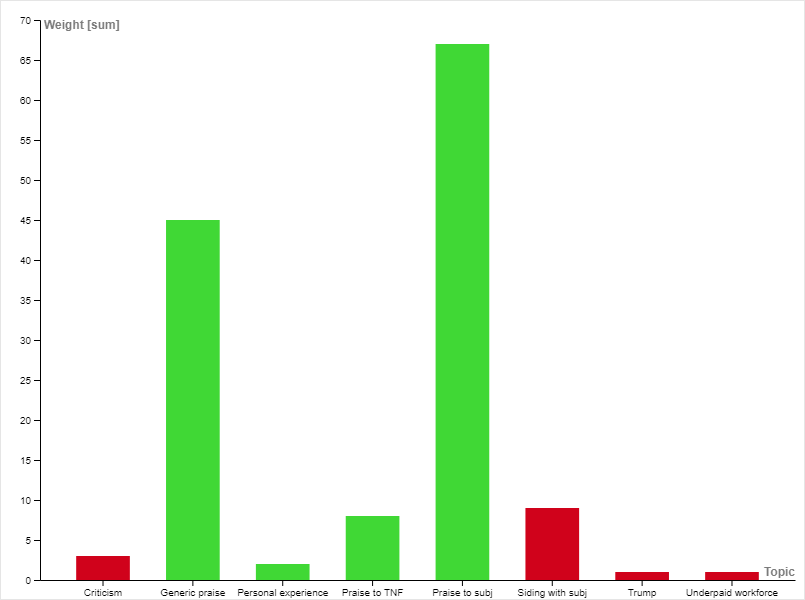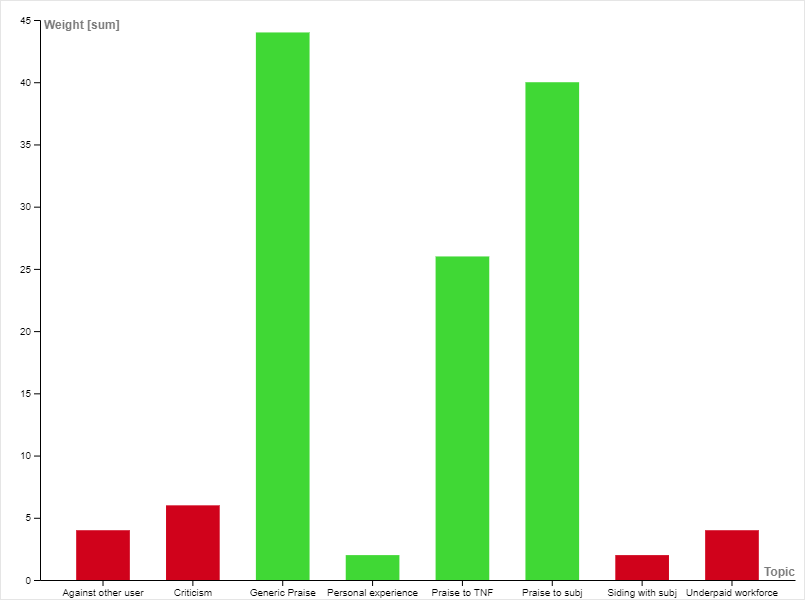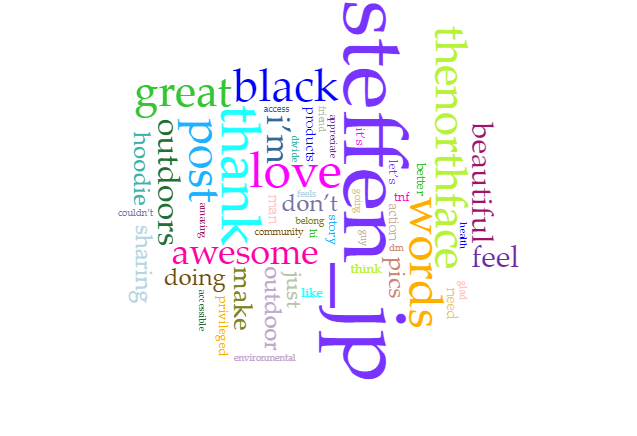Consumers reactions to The North Face’s political stances on diversity and inclusion on Instagram
As protests against racial inequity spread from the US to the world, not only individuals but also companies started using social media as a mean to show solidarity with the Black Lives Matter movement (BLM). Founded back in 2013, this movement resurfaced in May 2020, after the killing of George Floyd in police custody brought attention to issues of inequality in the American justice system.
While protests became more widespread and louder, companies felt compelled to respond in some way, and therefore adopted a wide variety of strategies, from sharing a black square, to explicitly stating their solidarity with the movement, to donating money to racial justice causes. This urgency to take a stand felt particularly incumbent upon those brands that practiced Brand Activism before – a common practice, indeed, in the field of outdoor firms (just think of Patagonia). One of these activist outdoor brands is The North Face, which in fact spoke up on issues like climate (Protect Our Winters), access to the outdoors (Explore Fund), and misinformation and hate speech (#StopHateforProfits).
Now, when brands take a stand, how are such political stances about diversity and inclusion perceived by consumers? Do they sound authentic? And which strategies seem to be more convincing?
Authentic Brand Activism or Woke Washing?
As described by Vredenburg et al. (2020), Brand Activism is an “emerging marketing tactic for brands seeking to stand out in a fragmented marketplace by taking public stances on social and political issues”. The simple will to take this step, though, seems unlikely to go far without another important element: authenticity. Significantly enough, to exemplify the importance of authenticity, the authors look at the numerous brands that, after siding with BLM protesters, were accused of lack of supportive values and practice (i.e. having Black board members).
The views that influence a company’s position to be politically active, as suggested by Moorman (2020), can be different: is the brand inspired by a Political mission view, where the company’s raison d’être is inextricably linked to social change, or is it led by a Calculative view, a simple evaluation of gains vs. losses? Whatever the reason that drives companies, the final verdict comes from the perception of the consumer, who tells authentic Brand Activism from Woke Washing.
In such rough seas, though, not even playing it safe appears to be the best choice. In fact, as researchers show (Korschun et al., 2019), a values-driven company abstaining from a stand can be considered as hypocritical as a market-driven company taking a stand, “because the values-driven company can take a stand, yet chooses not to”.
How did an activist outdoor brand like The North Face, then, decide to act? Or better, provided that silence did not seem an option, what reactions did the political stances on diversity and inclusion elicit on Instagram – which according to Zhang (2020) is considered the best social media to build brand communities by many outdoor firms? And lastly, did different strategies employed in taking such stands result in different reactions?
Let’s gear up to attempt this climb.
From content to sentiment
In order to lay the groundwork for the subsequent Sentiment Analysis, a preliminary Content Analysis was carried out by collecting a dataset of 358 posts from the official Instagram profile of The North Face (@thenorthface) between April 2019 and October 2020. Within this time frame lies a watershed data: May 31st, the day of the brand’s first political stance on racism, only 6 days after the killing of George Floyd. More than 60% of the posts that mention diversity and inclusion (11% of the total) were published after this date, in just four months, compared to the scarce 40% of the previous 14 months.
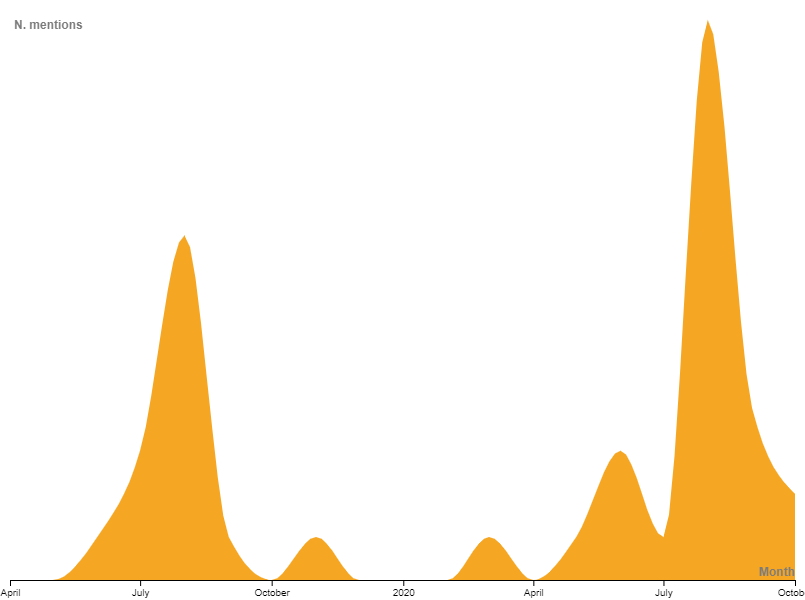
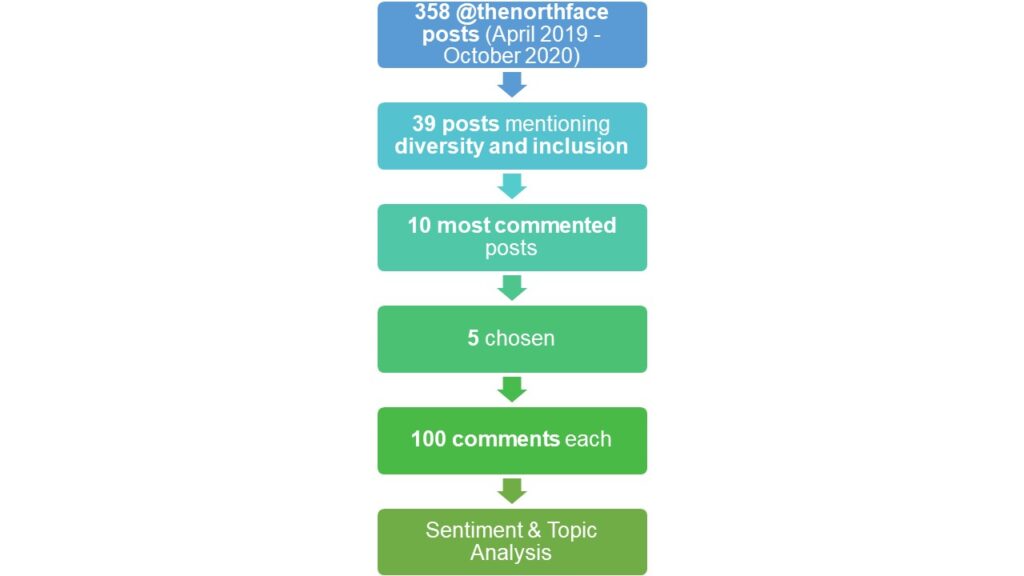
Subsequently, of the 39 posts that include a mention of diversity and inclusion in their caption, the 10 most commented posts were isolated. This set of 10 high engaging posts about diversity and inclusion was further halved with a purposive sampling based on variety and meaningfulness criteria that will become more evident in the following paragraphs. For each of these 5 posts, then, 100 comments were extracted with random sampling, thereby forming the basis for a manual Sentiment and Topic Analysis.
As defined by Caliandro & Gandini (2017), Sentiment Analysis “is a research technique that is used to measure the emotional attitude a digital text expresses toward a given object” – in this case, the brand as a political activist. Sticking to the canonical categories, the comments were classified as positive, negative, or neutral in terms of sentiment, besides being weighted (1-3) based on the intensity of the message conveyed. Despite being both positive, in fact, comments like “????????❤️” and “GOD BLESS YOU @thenorthface Your company makes amazing products besides being a socially conscious brand #blacklivesmatter” will not fairly have the same weight on the final result. Lastly, to investigate deeper the reasons for a certain sentiment, the comments were also coded in terms of Topic.
Now we are all set up to try and gaze into the horizon from this pile of data.
“Thank you for sharing your experience”
In the first two posts analysed, The North Face leaves the floor to two people of colour who address the issue of diversity and inclusion in the outdoors through personal experience. New Jersey photographer @wildginaaa describes her first problematic attempt to buy a pair of climbing shoes (“it’s weird to see you in here because Black people don’t hike or climb”), while the snowboarder and rock climber @steffen_jp reports the access barriers to outdoor spaces for a Black man (“I often try to make myself “less intimidating.” I am careful where I travel, knowing that some areas may not be as welcoming to me as others”).
In both cases, the sentiment is largely positive, while negative comments are often used to side with the subject (“That guy is a jerk and makes me ashamed to carry this nasty white skin”). The layout of the sentiment in these first two posts seems to prove a fact of common knowledge: as human beings, we tend to be empathic with others.
A glance at topics provides further insight.
Much of the positive sentiment comes from comments classified as “Generic praise” (“????????????????????”, “Aye ????????????????????”, “Wonderful”): admittedly, part of such comments, with no specific reference to the image or caption, could also come from real and bot accounts merely seeking visibility. Negative comments expressing a generic or specific criticism are not absent, but however limited. What is remarkable, confirming the “empathic hypothesis” suggested above, is the great attention and sympathy addressed to the protagonists of the posts, which stands out clearly from a Keyword Analysis of the comments.
“Looks so wrong”

Like every good rule has an exception, the hypotheses put forward above already has a setback. In the third post considered, the climber and photographer @urbanclimbr narrates her experience similarly to what seen above, but with at least two significant differences. First, the reference to racial injustice is more direct (“I wanted to highlight a burst of joy outside especially after the last wave of social unrest. It hurts to see reoccurring imagery of despair of people who looked like me”). Secondly, this post occurred with a bad timing: it was published on 18/06, just a couple of days after the divisive announcement of The North Face pulling Ads from Facebook. These two reasons seem to have caused an uncertain sentiment towards the post.
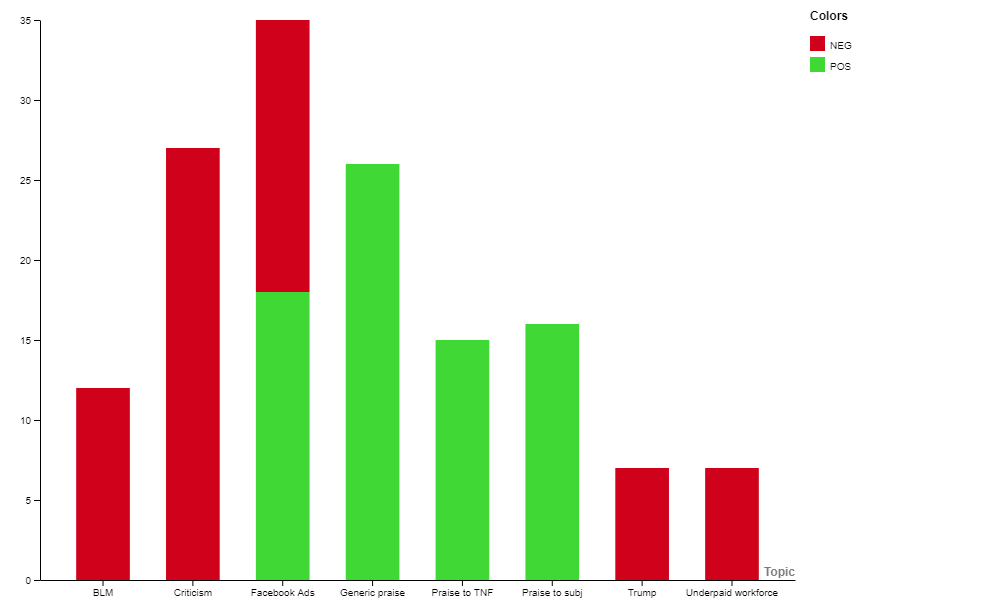
The divisiveness of the decision on Facebook Ads emerges clearly from the Topic Analysis (some consider it “anti-American” and “against freedom of speech”, while many applaud it as a stand against misinformation and hate speech). In many cases the negative sentiment is related directly to Black Lives Matter (“All lives matter! Stop your lame pandering!”), to President Trump (“TRUMP 2020 ???????????????????????????????? #alllivesmattersupport”) and to the tricky issue of underpaid workforce, which will be explored further in the following lines. And just like generic praise, also generic criticism holds an important place, even with an often aggressive tone (“Out of control with dumbness”, “Pandering Imbeciles at ClownFace! ????????????????”). Beyond all of this, positive comments rank (narrowly) first. The topic-pattern is similar to the previously considered posts in terms of generic praise (the most part) and wide praise to the subject, while a praise to the brand in this case is proportionately more present.
“Virtue signalling sooths your guilty conscience”

The statement is direct, unmistakable, and loud – and so is the negative sentiment, which almost reaches the 70%. Not surprisingly, the main source of negative comments are users attacking directly (and often violently) BLM movement, defined as a “black supremacist organization” and “terrorists”. Another reason for criticism is the issue of The North Face using underpaid workforce in countries like China and Indonesia, resulting therefor incoherent (“So black lives matter but ouïgours[1] lives no? SHAME! ????????”). Many of the accusers suggest that The North Face should do more than just speaking up and donating. They should commit with action at a corporate level (“@thenorthface your post speaks to community action. What is your brand doing to ensure sourcing diverse candidates? What percentage of your corporate workforce is diverse?”, “one of your first steps should be taking a look internally at the lack of diversity within your organization #pulluporshutup”). On the other hand, there are still users that applaud The North Face’s stand, considering it authentic Brand Activism (“Thank you TNF for being a socially conscious brand!”).
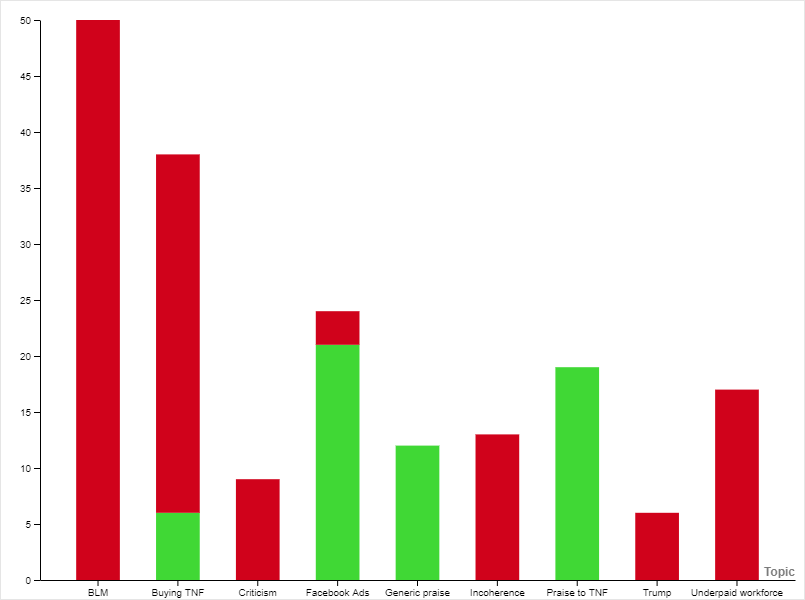
“Beautiful and subtle”

“Walls are meant for climbing” is the claim chosen for the Global Climbing Day (22/08), but clearly, it is more than that. Users don’t get past the hint, and immediately lead the topic back to border security and President Trump, some in a playful and endorsing way (“@realdonaldtrump they got you there”), the most part disapproving instead (“No. It’s meant to protect the greatest country this world has ever seen!”). Many recognise this as an obvious political stance, which a brand like The North Face should avoid (“you’re a clothing manufacturer and not a f*cking politician”, “Stick to clothing and drop the political bullsh*t”). But still, congratulations for the clever idea abound, and positive sentiment ends up prevailing (“Love this campaign”, “Love the controversy this has brought!”).
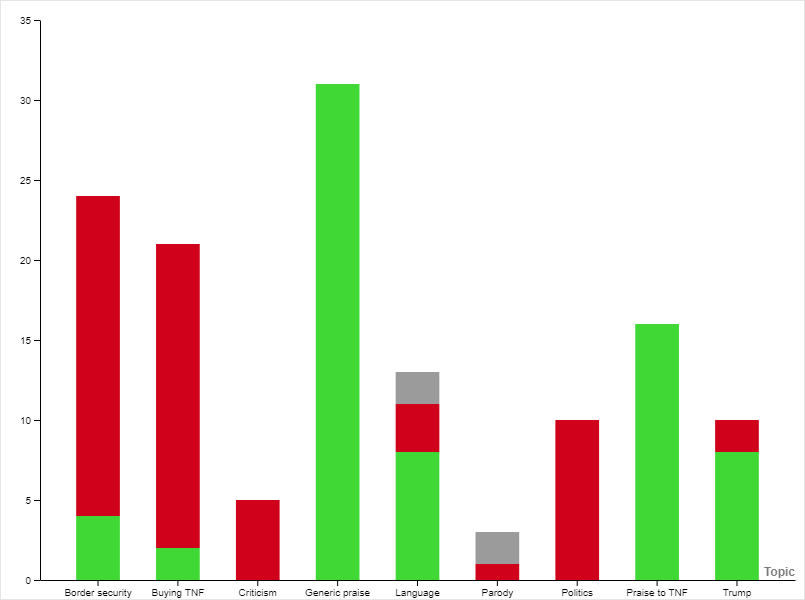
To buy or not to buy
Both the supporters and the critics seem to agree on at least one point: in the end, it is all about buying. The topic stands out in the last two posts considered, where users openly express their intention to either boycott or buycott (see Neilson, 2010) the brand. Be it a “fan” (“I just bought a new backpack from your brand after you’ve pulled advertising from Facebook!”) or a “hater” (“IM NOT BUYING FROM THE NORTH FACE EVER AGAIN”), the consumer seems to understand that it’s not just a matter of politics and social justice: the business aspect is, beneath it all, unforgotten.
Now that the climb is concluded, what considerations could we outline on the “summit book” for the next ones venturing up?
Staying human. Not surprisingly, consumers are more likely to trust and consider the voice of another human being than a faceless big company. However, the more direct the reference to a political issue, the less successful the softening effect of a human face. Moreover, the mention of a political issue can easily lead to another (not necessarily related) one.
Casting the first stone. Openly taking a political stand on a divisive issue is a gamble in which high engagement and negative reactions are highly expectable. Before taking such a decision, companies need to be really sure to be “without sin”, since increasingly distrustful consumers won’t hesitate to inspect and question the brand (remember Authenticity?).
Optimal congruence. The toughest question was glimpsed by many users: why should a clothing brand get into politics? When the political issue is imposed by the context, a relevant entry point is crucial, something that requires “greater elaboration and deeper processing for consumers” (Vredenburg et al., 2020, on optimal incongruence). It can’t be just a statement out of the blue. It needs to be something about which the brand, with its history and values, can claim to have a say: “Walls are meant for climbing”.
Despite all the efforts, anyways, consumers seem to be aware that no company (not even Patagonia) is actually “in business to save our home planet”, but naturally to seek profit and buyers.
[1] The North Face, together with many other fashion brands, was accused of using products made with the forced labour of Uighur Muslims in China (the company denied).
References
Arvidsson A., Caliandro A. 2016. Brand Public. Journal of Consumer Research. 42(5):727–748
Caliandro A., Gandini A. 2017. Qualitative Research in Digital Environments: A research toolkit. New York: Routledge.
Carney N. 2016. All Lives Matter, but so Does Race: Black Lives Matter and the Evolving Role of Social Media. Humanity & Society;40(2):180-199.
Korschun D., Aggarwal A., Rafieian H., Swain S. D. 2019. Taking a Stand: Consumer Responses When Companies Get (or Don’t Get) Political. Available at SSRN.
Minocher X. 2019. Online consumer activism: Challenging companies with Change.org. New Media & Society;21(3):620-638.
Moorman C. 2020. Commentary: Brand Activism in a Political World. Journal of Public Policy & Marketing;39(4):388-392.
Neilson, L. 2010. Boycott or buycott? Understanding political consumerism. Journal of Consumer Behaviour, 9, 214-227.
Vredenburg J., Kapitan S., Spry A., Kemper J.A. 2020. Brands Taking a Stand: Authentic Brand Activism or Woke Washing? Journal of Public Policy & Marketing;39(4):444-460.
Zhang J.S. 2020. Outdoor sports brands’ strategies for building Instagram brand community. Available at IDEALS.



